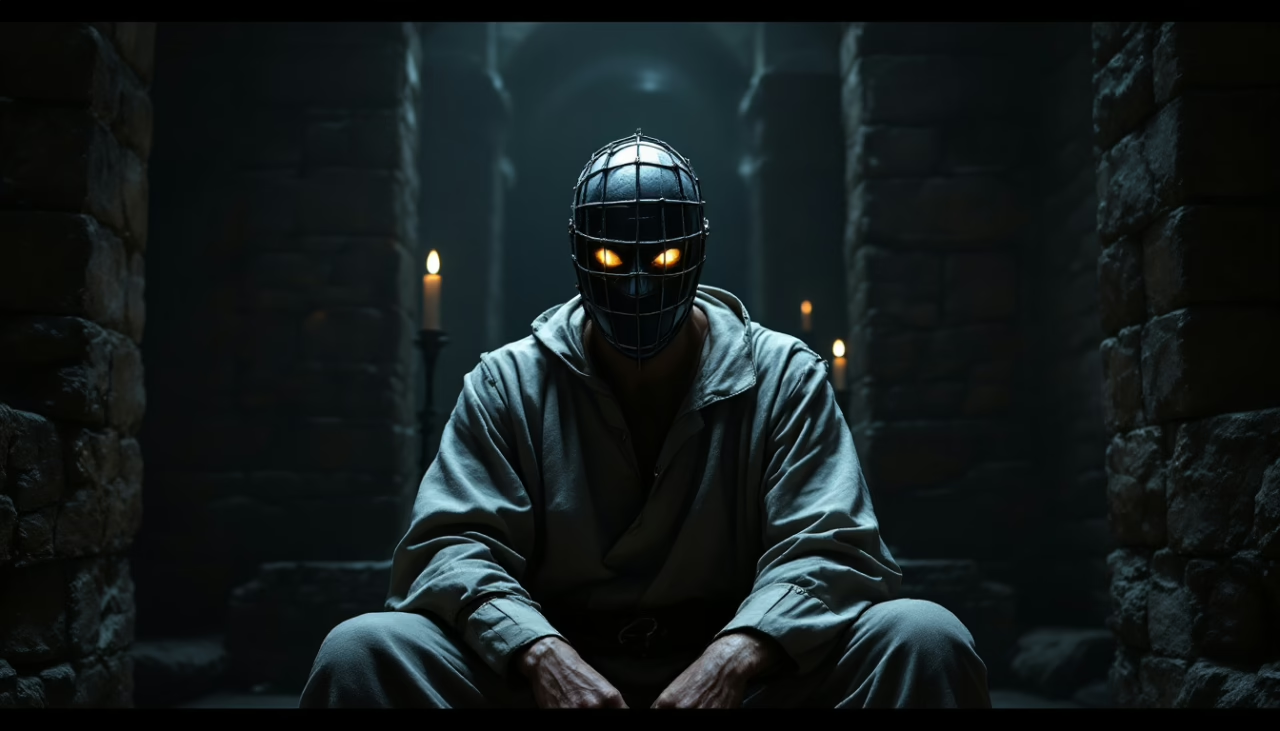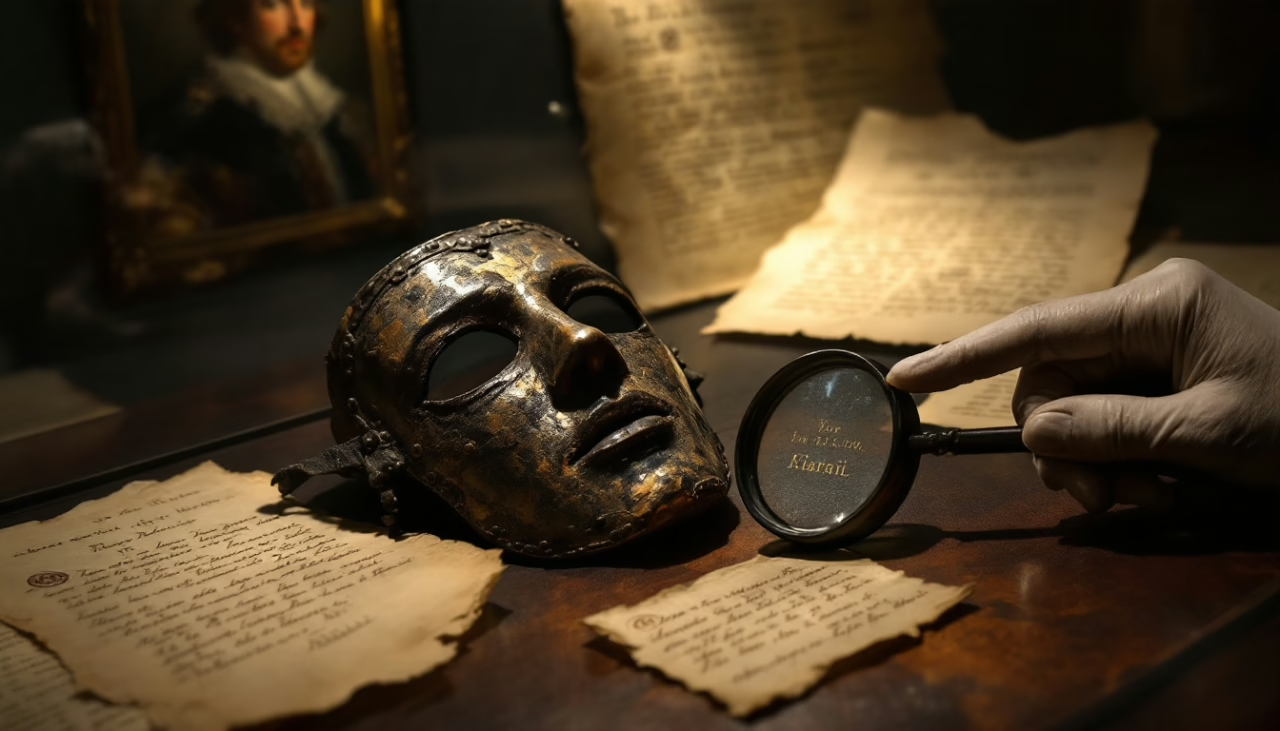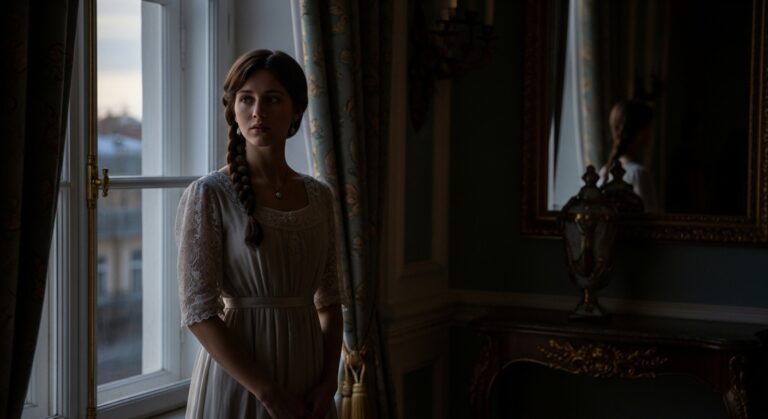Mystery of the Man in the Iron Mask Solved?

Man in the Iron Mask: History’s Greatest Mystery – The Man in the Iron Mask—a prisoner confined in several French fortresses from 1669 until his death in 1703—stands as one of history’s most tantalizing enigmas.
His identity, obscured by royal decree and the mask he was forced to wear, has spawned centuries of speculation among historians.
Despite numerous theories, from Louis XIV’s illegitimate brother to a disgraced nobleman, conclusive evidence remains elusive.
Modern forensic techniques offer new investigative avenues, yet the truth behind this baroque-era mystery continues to elude scholars’ grasp.
Principal Conclusions
Hide- No definitive solution has been universally accepted by historians despite centuries of investigation into the masked prisoner's identity.
- Modern scholars increasingly favor Eustache Dauger, a disgraced valet with dangerous knowledge, as the most likely candidate.
- DNA testing of remains has been proposed but faces challenges due to limited verifiable genetic material from historical candidates.
- Historian Paul Sonnino's research suggests the prisoner was likely a conventional criminal rather than a royal twin.
- The extraordinary security measures around the prisoner indicate political significance rather than personal importance to Louis XIV.
Historical Background: Origins of the Legend of Man in the Iron Mask

The enigmatic prisoner, known as the Man in the Iron Mask, first appeared in historical records during Louis XIV’s reign, when contemporaneous accounts documented a mysterious inmate whose identity remained concealed behind an elaborate facial covering.
Within the fortified walls of various French prisons, including the Bastille, this nameless detainee lived under extraordinary security measures, with guards instructed to kill him should he reveal his identity.
The initial written testimonies, particularly those by Voltaire in the mid-eighteenth century, transformed what might have been merely an unusual incarceration into one of history’s most enduring mysteries, propelling speculative theories about royal illegitimacy and political intrigue that continue to fascinate scholars centuries later.
First Accounts of the Masked Prisoner
The first documented accounts of the mysterious masked prisoner emerge in late 17th-century Bastille records, where meticulous notations reveal extraordinary security protocols surrounding an unnamed detainee.
Correspondence between Louis XIV’s ministers, particularly the cryptic exchanges between Saint-Mars and Louvois in 1687, references a prisoner of exceptional status whose identity required absolute concealment.
These initial historical fragments, scattered across official registers and private journals of the period, established the foundation for what would become one of France’s most enduring historical enigmas, transformed over centuries from bureaucratic footnote to legendary speculation.
Historical Records from the Bastille
Official prison registers from the Bastille provide our earliest documentary evidence of the mysterious masked prisoner, though these records remain tantalizingly incomplete.
Recent archival discoveries have unearthed documentation of his severe isolation and peculiar treatment.
The Bastille archives detail austere prison conditions while deliberately obscuring the masked identity—suggesting the historical significance of concealing this captive from public knowledge.
Early Mentions in French Letters and Journals
While official Bastille records provide essential documentation of the Iron Mask‘s existence, earliest public awareness emerged through private correspondence and journals circulating among French aristocratic circles in the late 17th century.
These early correspondences—predominantly journal entries from courtiers and diplomatic communiqués—shaped cultural perceptions of the prisoner long before Voltaire’s famous literary references transformed the enigmatic captive into an enduring symbol of state oppression within historical narratives.
The Prisoner’s Life Behind Bars
Contemporary accounts of the Iron Mask prisoner reveal a paradoxical existence—one of exceptional security measures coupled with surprising comforts accorded to few inmates of the era.
Guards were reportedly instructed never to glimpse the prisoner’s face, with Saint-Mars, his primary jailer, bound by oath to dispatch the captive should he attempt to communicate his identity to anyone.
Despite these harsh restrictions, correspondence between officials indicates the prisoner received fine linen, quality meals served on silver plates, and occasional musical instruments—curious privileges that have only deepened the historical enigma surrounding his status and importance.
Known Conditions of His Imprisonment
Records from the Bastille archives reveal that the Man in the Iron Mask lived under extraordinarily strict conditions of confinement, even by the harsh standards of 17th-century imprisonment.
His isolation effects proved profound through:
- Strict treatment policies forbidding him to communicate with anyone
- Sparse cell environment with minimal furnishings
- Guards ordered to kill him upon mask removal
- Unprecedented confinement duration spanning decades
Reports of His Treatment and Guards’ Testimonies
According to firsthand accounts from Bastille personnel, the Man in the Iron Mask received treatment that blended unusual courtesies with profound dehumanization, creating a paradoxical existence that has confounded historians for centuries.
Guard testimonies recorded in historical documentation reveal that while permitted fine clothing and exceptional cuisine, this enigmatic prisoner faced perpetual isolation, his true identity concealed behind the notorious mask—a condition eyewitness accounts describe as “living death.”
Identity Theories: Who Was He?
Numerous theories regarding the Man in the Iron Mask‘s identity have circulated among historians, ranging from a hidden royal twin sequestered to prevent dynastic complications to a high-ranking political prisoner whose knowledge threatened the French monarchy’s stability.
Some scholars point to circumstantial evidence suggesting he may have been a diplomatic agent or spy whose capture necessitated extraordinary measures of concealment, particularly given the elaborate security protocols documented in correspondence between his jailers.
The mystery endures precisely because the French crown expended such remarkable resources to obliterate this prisoner’s identity from historical records, suggesting his mere existence represented an existential threat to the established order.
Royal Blood: The Hidden Twin Theory
The tantalizing theory that the Man in the Iron Mask was Louis XIV’s unacknowledged twin brother emerges from contemporary whispers at Versailles and suggestive palace correspondence hinting at a dangerous royal secret.
Historical accounts from courtiers, particularly those of Voltaire, lend credence to this hypothesis by noting the prisoner’s regal bearing and the extraordinary security measures implemented for someone of seemingly ordinary status.
Yet this theory confronts formidable challenges: no definitive birth records confirm a royal twin, the practical complications of hiding a pregnancy from the court appear insurmountable, and Louis XIII’s documented separation from Anne of Austria during the relevant conception period undermines the biological plausibility of the claim.
Connections to King Louis XIV
Perhaps the most tantalizing theory surrounding the Man in the Iron Mask suggests he shared royal blood with Louis XIV himself—specifically as an identical twin brother whose very existence threatened the stability of the French monarchy.
Louis XIV’s court intrigues reveal patterns of royal deception that parallel other historical cases of political manipulation.
Primary sources suggest:
- Secret birth records deliberately destroyed
- Unusual palace security protocols
- Disproportionate resources expended on a single prisoner
- Striking physical resemblances noted by multiple witnesses
Evidence Supporting and Challenging This Theory
Evidence for the hidden twin theory appears in several intriguing historical fragments, though scholars remain divided on their validity.
Royal secrecy surrounding the masked prisoner fuels ongoing identity speculation.
Voltaire’s cryptic allusions to the prisoner’s royal features and subsequent cultural legacy suggest historical significance beyond mere coincidence.
Yet critics note the disturbing absence of birth records or compelling primary documentation that would definitively establish this provocative genealogical connection.
Political Prisoner: High-Ranking Official or Rival?
Nicolas Fouquet, Louis XIV’s once-powerful Superintendent of Finances, emerges as a compelling candidate for the Iron Mask‘s true identity, particularly given his dramatic fall from grace and subsequent imprisonment after 1661.
Beyond Fouquet, scholars have identified other political figures—notably the Duke of Beaufort and diplomat Ercole Mattioli—whose sudden disappearances from public life coincided suspiciously with the masked prisoner’s confinement.
These high-ranking officials, each possessing knowledge that might threaten the French monarchy, represent alternatives to royal bloodline theories, suggesting the mask concealed not a familial secret but a political liability deemed too dangerous to execute yet too volatile to release.
Possibilities of Minister Fouquet
Among the compelling candidates for the Man in the Iron Mask, Nicholas Fouquet, Louis XIV‘s ambitious Superintendent of Finances, stands as a particularly intriguing possibility.
Fouquet’s ambitions threatened the king’s authority, potentially triggering his imprisonment rather than political exile.
Consider these dimensions:
- Secret negotiations with foreign powers
- Personal vendettas within Versailles
- Loyalty dilemmas among courtiers
- Knowledge of state finances too dangerous to expose
Other Political Figures of Interest
While Fouquet has garnered significant scholarly attention, several other political figures emerge as compelling candidates for the mysterious prisoner behind the iron mask.
Political intrigue surrounding Louis XIV’s court reveals potential identities including the king’s illegitimate brother or rivals eliminated through royal secrets rather than public execution.
Historical conspiracies suggest espionage tactics were deployed to permanently silence enemies whose existence threatened the monarchy—creating cultural symbolism that endures centuries later.
Secret Agent or Spy
Several historical accounts suggest the masked prisoner may have been a diplomatic agent or intelligence operative whose knowledge posed a significant threat to French national interests.
Documents preserved from Louis XIV’s reign indicate abnormally heightened security protocols for the prisoner—measures typically reserved for those possessing state secrets rather than mere political rivals.
The espionage theory gains credibility when examining correspondence between ministers Louvois and Saint-Mars, which contains cryptic references to information that, if revealed, could “compromise relations with our allies,” suggesting the prisoner’s mask served less as punishment and more as a safeguard against recognition by foreign dignitaries who might have encountered him in diplomatic circles.
Claims and Evidence of Espionage
How deeply the prisoner’s identity was enmeshed with espionage remains one of the most compelling theories surrounding the Man in the Iron Mask.
Archives suggest his confinement stemmed from intelligence networks that threatened monarchical stability.
Evidence points to:
- Intercepted diplomatic correspondence
- Testimony from royal guards regarding espionage tactics
- Documented undercover operations throughout European courts
- Financial records indicating payment for political intrigue
Potential Motives for Secrecy
The notorious secrecy surrounding the Man in the Iron Mask‘s identity suggests powerful political motives transcending mere punishment for common crimes.
Within the historical context of Louis XIV’s absolutism, royal intrigue demanded extraordinary measures to manage public perception.
The secrecy motivations likely stemmed from threats to succession legitimacy or evidence of political maneuvering that would undermine the Sun King’s carefully constructed image of divine authority.
Cultural Impact and Popularization
The enigmatic prisoner‘s cultural resonance transcends historical obscurity, manifesting most notably in Alexandre Dumas’ 1847 novel “The Man in the Iron Mask,” which transformed the mysterious figure into an enduring literary archetype.
Dumas’ fictional portrayal, suggesting the masked prisoner was Louis XIV’s identical twin, captured public imagination and established the template for subsequent interpretations across media.
This enthralling narrative has inspired numerous cinematic and television adaptations—from the 1939 film starring Louis Hayward to Leonardo DiCaprio’s dual role in the 1998 version—each reinterpreting the masked prisoner’s plight while perpetuating the legend’s allure in popular consciousness.
Influence of Alexandre Dumas’ Novel
Alexandre Dumas’ 1847-1850 novel “The Man in the Iron Mask” transformed a historical footnote into an enduring cultural phenomenon, though his fictional portrayal—suggesting the prisoner was Louis XIV’s identical twin—diverged substantially from documented evidence.
The romanticized narrative, with its themes of royal intrigue and hidden identity, catapulted the enigmatic prisoner into popular consciousness through subsequent adaptations in theater, film, and literature.
Primary accounts from the period indicate a far less sensational reality than Dumas depicted, yet his narrative has become so thoroughly embedded in collective imagination that the historical facts often struggle to compete with his compelling, if largely invented, version of events.
Fiction vs. Historical Facts
Few historical enigmas have undergone such dramatic transformation in public imagination as the Man in the Iron Mask, whose mysterious imprisonment became literary legend through Dumas’ wildly popular 1847-1850 novel, “Le Vicomte de Bragelonne.”
Dumas, with characteristic narrative flourish and disregard for historical accuracy, reimagined the anonymous prisoner as Louis XIV’s identical twin brother, creating a compelling fraternal intrigue that captured readers’ imaginations far more effectively than the sparse historical documentation ever could.
- Historical records confirm only an unnamed prisoner whose face was concealed
- Dumas’ fictional narrative transformed factual ambiguity into definitive royal conspiracy
- Cultural interpretations vary wildly between scholarly analysis and popular literary adaptations
- The narrative influence of fiction often supersedes historical accuracy in public consciousness
Role in Popularizing the Legend
A landmark achievement in literary mythmaking, Dumas’ “Le Vicomte de Bragelonne” catapulted the obscure historical footnote of a masked prisoner into the pantheon of enduring cultural legends.
Its legendary influence transcended literature, establishing potent cultural symbolism of state oppression.
This narrative evolution sparked countless media portrayals, from Leonardo DiCaprio’s film interpretation to scholarly examinations of historical myths surrounding this enigmatic figure.
Adaptations in Film and Television
The Man in the Iron Mask legend has inspired numerous cinematic adaptations, with each filmmaker’s interpretation shaping public understanding of this enigmatic historical figure. Notable productions include the 1939 film starring Louis Hayward, the 1977 version with Richard Chamberlain, and the 1998 Hollywood rendition featuring Leonardo DiCaprio, each offering distinct visual representations that have crystallized the masked prisoner in popular imagination.
While Dumas’ literary work established the foundational narrative, these film and television adaptations have introduced significant variations in the prisoner’s characterization, altering key plot elements and historical contexts to serve dramatic purposes rather than historical accuracy.
Famous Interpretations in Cinema
Cinema immortalized the enigmatic prisoner in adaptations that transformed historical obscurity into cultural prominence, beginning with Douglas Fairbanks Sr.’s swashbuckling portrayal in the 1929 silent film “The Iron Mask.”
Throughout subsequent decades, Hollywood continuously reimagined the mysterious figure, particularly in the 1939 version starring Louis Hayward, followed by the 1977 made-for-television movie with Richard Chamberlain.
- Cinematic portrayals often emphasized thematic elements of identity and power
- Narrative techniques varied across adaptations, from melodrama to historical fiction
- Character motivations reflected contemporary social concerns rather than historical accuracy
- Audience reception typically favored spectacle over adherence to documented facts
Differences in Depictions Across Media
While literature originally introduced the masked prisoner to the public imagination, visual media has dramatically transformed the Man in the Iron Mask through increasingly divergent interpretations across film, television, and graphic narratives.
These media representations reveal striking depiction differences, with Hollywood typically sacrificing historical accuracy for dramatic narrative variations.
Modern artistic interpretations frequently emphasize themes of identity and oppression, reflecting contemporary values rather than seventeenth-century realities.
Investigating Historical Clues
Historians examining prison records and official correspondence from Louis XIV’s reign have encountered perplexing inconsistencies, alternative names, and deliberately obscured information regarding the masked prisoner’s true identity.
The physical attributes of the mask itself—whether truly iron or merely velvet with metal reinforcements—remain contested among scholars who have analyzed contemporaneous accounts and the practical logistics of long-term metal mask usage.
These fragmentary historical clues, tantalizing yet inconclusive, continue to fuel scholarly debate about which of the numerous candidates—from disgraced nobles to royal relatives—actually endured this peculiar punishment.
Prison Records and Official Documents
Prison records concerning the Iron Mask prisoner exhibit striking inconsistencies, with correspondence between officials omitting critical details about the prisoner’s identity and the nature of his crimes.
Nineteenth-century historians uncovered several contradictory transfer documents that refer to the prisoner alternately as “l’ancien prisonnier” and “le prisonnier masqué,” suggesting possible deliberate obfuscation within official channels.
Recent archival research at the Bibliothèque Nationale has revealed previously overlooked financial records indicating unusually high expenditures for this particular prisoner’s maintenance, providing tantalizing new evidence regarding his significance to the French crown.
Inconsistencies and Missing Information
Where do the greatest challenges in unraveling the Man in the Iron Mask mystery lie?
Historical ambiguity permeates the case through incomplete records and conflicting accounts that frustrate definitive conclusions.
Critical documentary gaps reveal systemic inconsistencies:
- Missing interrogation transcripts
- Unreliable sources with political motivations
- Deliberately altered prison registers
- Conflicting accounts from contemporaneous witnesses
These evidentiary voids perpetuate the enigma, maintaining the mask beyond death.
New Findings from Historical Research
Recent archival discoveries have dramatically reshaped our understanding of the Iron Mask enigma, unearthing previously overlooked documentation within France’s national archives.
These findings challenge centuries of identity speculation while illuminating the deliberate mechanisms of royal secrecy.
Beyond establishing historical accuracy, the documents reveal how this prisoner’s narrative legacy transcended mere incarceration to become profound cultural symbolism of absolute monarchical power.
Analysis of the Iron Mask Itself
The question of whether the infamous “iron mask” actually existed as a physical restraint, or merely represented a symbolic metaphor for extreme isolation, remains central to unraveling this historical enigma.
Contemporary accounts describe variously a mask of “black velvet” or one fashioned from metal, suggesting that historians must reconcile contradictory primary sources to establish the material reality behind the legend.
Close examination of these descriptions offers potential insights into both the practicality of such a device and its intended purpose—whether designed primarily for punishment, concealment of identity, or psychological torment of a prisoner whose face was deemed too dangerous to be seen.
Real Mask or Symbolic Metaphor?
Precisely what constitutes the infamous “iron mask” remains one of historiography’s most contested elements in the enigmatic case of Louis XIV‘s mysterious prisoner.
Historical accounts vacillate between literal and metaphorical interpretations, each carrying profound cultural symbolism and political implications.
- Physical constraint or literary embellishment?
- Symbol of absolute monarchical power
- Manifestation of identity erasure
- Catalyst for revolutionary sentiment against state oppression
Material and Design: Clues to Its Purpose
Historical evidence regarding the actual composition of the notorious “iron mask” reveals significant discrepancies from its popular portrayal, casting doubt on the traditional narrative while offering tantalizing clues about its intended function.
Meticulous craftsmanship analysis suggests the mask materials—likely velvet over metal rather than pure iron—served a design purpose balancing punishment with practicality.
Its cultural symbolism reinforcing isolation without physical torture presents a nuanced historical significance.
Conspiracy Theories and Speculations
The enigmatic prisoner’s identity transcends documented evidence, spawning myriad theories about clandestine royal affairs and succession crises within the French monarchy.
Historians have proposed several alternative suspects beyond the conventional candidates, including an illegitimate royal sibling, a disgraced minister with dangerous knowledge, or even a foreign diplomat whose existence threatened international relations.
These speculations, while lacking definitive proof, illuminate the labyrinthine nature of Bourbon politics and the extraordinary measures Louis XIV’s regime employed to preserve secrets deemed hazardous to the stability of the state.
Hidden Secrets of the French Monarchy
The potential threat to royal legitimacy posed by the Man in the Iron Mask represents a cornerstone of persistent speculation surrounding Louis XIV‘s secretive imprisonment policies.
Historians have identified numerous reasons why the French crown might have orchestrated an elaborate cover-up, including theories that the prisoner was Louis’s illegitimate half-brother or twin, whose very existence threatened the Sun King’s divine right to rule.
These conspiracy theories, while lacking definitive historical evidence, illuminate the monarchy’s obsession with controlling information that might undermine the carefully cultivated image of absolute power, particularly during a period when questions of succession remained politically volatile.
Potential Threats to Royal Legitimacy
Why did Louis XIV, Europe’s most powerful monarch, go to such extraordinary lengths to conceal the identity of a prisoner whose very existence threatened the foundations of his reign?
The Sun King’s meticulous concealment suggests profound royal power anxieties.
Consider:
- Illegitimate royal sibling challenging succession legitimacy
- Foreign agent with destabilizing diplomatic intelligence
- Witness to royal indiscretions threatening public perception
- Holder of documentation undermining monarchy’s theological claims
Reasons for Cover-up by the Crown
While numerous theories circulate regarding the French crown’s extraordinary measures to conceal this prisoner’s identity, historians have identified several compelling motivations that extend beyond mere political expediency.
Royal secrets concerning illegitimacy, monarchy scandals involving foreign powers, and historical deception designed to maintain the divine authority narrative all converged, creating crown motives for unprecedented secrecy.
Political intrigue, at its most consequential, demanded absolute containment.
Alternative Theories and Lesser-Known Suspects
Beyond the conventional theories surrounding Louis XIV’s court, historians have examined potential connections to foreign nobility, including an Italian diplomat who vanished from Venice and an Armenian prince whose disappearance coincided with the masked prisoner’s emergence.
The case parallels other mysterious incarcerations throughout European history, particularly that of Count Matthioli, a Mantuan minister arrested after double-crossing Louis XIV in diplomatic negotiations.
Primary documents from Bastille archives suggest the masked prisoner might have been merely one in a constellation of politically inconvenient individuals who, through historical accident rather than exceptional significance, became mythologized beyond their actual importance.
Theories About Foreign Nobility
Among the more speculative theories concerning the Man in the Iron Mask, several involve foreign nobility and diplomatic intrigue that extends beyond France’s borders.
Historical speculation regarding royal secrets has yielded compelling narratives of political intrigue involving noble lineage and foreign alliances:
- An illegitimate Habsburg prince concealed to prevent inheritance disputes
- A Swedish diplomat who discovered state secrets during alliance negotiations
- An Italian noble whose knowledge threatened Franco-Italian relations
- An Ottoman prince converted to Christianity, imprisoned to prevent diplomatic crisis
Other Mysterious Prisoners in History
Obscurity shrouds numerous historical prisoners whose identities and circumstances mirror the enigmatic case of the Man in the Iron Mask.
Throughout Europe’s fortified bastilles and remote dungeons, mysterious prisoners vanished from public record, becoming historical enigmas.
The Count of Monte Cristo’s inspiration, Dantès; Russia’s unsolved case of Princess Tarakanova; and England’s Arthur Savage—all represent documented instances where royal secrets necessitated hidden identities, their fates sealed by powerful regimes fearing exposure.
Modern Investigations and DNA Research
Recent scholarly investigations have employed cutting-edge scientific methods to penetrate the centuries-old enigma of the Iron Mask prisoner.
Forensic researchers have analyzed remnants from Saint-Marguerite and the Bastille, attempting to extract DNA evidence that might conclusively identify the mysterious captive against historical records.
These modern approaches, complemented by renewed examination of archived correspondence between Louis XIV and his ministers, represent the intersection of historical inquiry and technological innovation—transforming what was once pure speculation into evidence-based historical investigation.
Attempts to Identify Through Modern Science
Recent advancements in genetic science have prompted scholars to contemplate DNA analysis as a potential key to unfastening the iron-masked prisoner’s identity, though such efforts remain largely theoretical.
The most significant obstacle lies in obtaining verifiable genetic material from potential candidates, including preserved remains of aristocrats like Louis XIV’s rumored twin or the disgraced Nicolas Fouquet.
Despite these formidable challenges, historians and geneticists continue to explore innovative approaches that might one day reconcile documentary evidence with biological certainty, potentially resolving a mystery that has endured for over three centuries.
Possibilities of DNA Testing
While historical records have provided tantalizing clues about the Man in the Iron Mask, advances in genetic technology now offer unprecedented possibilities for resolving this centuries-old enigma.
Modern DNA analysis methods could potentially illuminate the genetic heritage implications of this mysterious figure.
- Sampling remains from potential candidates’ descendants
- Comparing mitochondrial DNA with royal lineages
- Cross-referencing results with historical documentation
- Addressing ethical considerations raised by posthumous testing
Challenges and Limitations of Scientific Approaches
Despite the promising avenues offered by forensic technology, scientific approaches to identifying the Man in the Iron Mask face formidable obstacles that have continually frustrated researchers.
Methodological challenges persist: evidence reliability deteriorates with time, historical accuracy becomes obscured through centuries of speculation, and scientific limitations impede conclusive findings.
Interdisciplinary approaches, though potentially illuminating, cannot overcome the fundamental problem—insufficient authenticated biological material for definitive identification.
Latest Historical Investigations
Recent historical investigations have sparked contentious scholarly debates about the iron-masked prisoner’s identity, with particular attention to previously overlooked correspondence between Louis XIV’s ministers.
Historians Jean-Christian Petitfils and Paul Sonnino have advanced competing theories—the former supporting Eustache Dauger as a valet privy to state secrets, while the latter proposes an Armenian archbishop who fabricated a plot against the king.
These fresh perspectives, though lacking definitive DNA evidence, offer methodologically rigorous analyses of primary documents within the socio-political context of 17th century European power dynamics.
Recent Scholarly Debates
In the twenty-first century, advanced forensic techniques and unprecedented access to archival materials have revolutionized scholarly understanding of the Iron Mask mystery.
Recent publications have sparked vigorous historiographical debates, challenging long-established identity hypotheses. Academic interpretations remain divided, yet a fragile scholarly consensus emerges around four primary theoretical frameworks:
- Documentary evidence suggesting royal lineage
- Cryptographic analyses of diplomatic correspondence
- Comparative examination of imprisonment records
- Contextual reassessment of Louis XIV’s security protocols
New Perspectives from Historians
Why has the Iron Mask prisoner captivated historical imaginations for centuries?
Contemporary historians approach this enigma with renewed scrutiny of primary sources, challenging traditional identity speculation.
Modern DNA analysis promises unprecedented historical accuracy, while scholars examine cultural representation and public perception surrounding the case.
The persistent royal secrecy, methodically maintained across generations, remains the compelling core of this enduring historical puzzle.
Enduring Fascination: Why the Mystery Persists
The Man in the Iron Mask continues to captivate our collective imagination, inhabiting a psychological territory where unsolved historical mysteries intersect with primal fears of identity erasure and unjust confinement.
This enigmatic prisoner, whose fate was to live anonymously behind metal, represents the ultimate historical loose end—tantalizing in its resistance to resolution despite centuries of inquiry.
From Alexander Dumas’ nineteenth-century fictionalization to contemporary films and academic discourse, the masked prisoner persists as a cultural touchstone, demonstrating how unresolved questions from the past can transcend their historical contexts to become enduring symbols of secrecy, power, and the human cost of state suppression.
Psychological Appeal of the Unknown
The perennial fascination with the Man in the Iron Mask stems from humanity’s psychological attraction to unresolved historical enigmas, where the absence of definitive answers creates space for imagination and speculation.
This masked prisoner transcends his historical context to become a potent symbol of suppressed truth, representing knowledge deliberately obscured by the powerful for reasons that remain tantalizingly beyond our grasp.
The iron mask itself—physically concealing yet metaphorically revealing—continues to function as an emblem of lost historical certainty, challenging each generation to confront the discomforting possibility that some mysteries are designed never to be solved.
Human Fascination with Unsolved Mysteries
Throughout centuries of historical inquiry, unsolved mysteries like the Man in the Iron Mask have maintained a powerful grip on our collective imagination, transcending mere academic curiosity to become cultural touchstones that resonate across generations.
Human curiosity manifests in our persistent engagement with historical enigmas, reflecting deeper psychological intrigue:
- Liberation through intellectual pursuit
- Connection to shared historical narratives
- Counterbalance to modern certainties
- Personal projection onto ambiguous figures
The Prisoner as Symbol of Lost Truth
Representing more than a mere historical footnote, the Man in the Iron Mask manifests as a profound symbol of lost truth in our collective consciousness, embodying humanity’s complicated relationship with the inaccessible past.
This mysterious figure’s Identity Concealment serves as a Cultural Reflection of our own struggles with obscured Historical Narratives, his iron-clad visage becoming a Symbolic Representation of knowledge forever beyond reach.
The Masked Prisoner in Today’s Culture
The enigmatic figure of the Iron Mask prisoner has transcended his historical origins to become a cultural touchstone, appearing in numerous films, novels, and theatrical productions that continue to reimagine his story for contemporary audiences.
This enduring cultural fascination extends beyond entertainment into historical tourism, where visitors to France seek out locations connected to the masked prisoner, particularly the fortress-prison of Pignerol and the Bastille’s former site.
The persistent allure of this centuries-old mystery demonstrates how unresolved historical questions, particularly those involving secrecy at the highest levels of power, maintain their grip on collective imagination across generations, cultures, and media forms.
Continued Influence in Literature and Media
Despite centuries having passed since his imprisonment, the Man in the Iron Mask continues to captivate modern imaginations across literature, film, and other media formats, demonstrating the remarkable longevity of this historical enigma.
- Literary adaptations reinvent his persona through narrative innovation
- Cultural symbolism transforms him into an archetype of unjust confinement
- Character development explores thematic tensions between power and identity
- Modern interpretations interrogate systemic oppression through his experience
Tourist Interest and Historical Tourism in France
While centuries of historical debate have failed to resolve the enigma of the masked prisoner’s identity, his legend has transformed into a significant cultural attraction across France, drawing thousands of tourists annually to sites associated with his imprisonment.
Historical reenactments and guided tours at heritage sites like the Bastille’s former location and the fortress-prison of Pignerol offer visitors immersive encounters with this enduring mystery, while regional cultural festivals commemorate his enigmatic legacy.
Final Thoughts
The Man in the Iron Mask stands at history’s crossroads: a silent prisoner juxtaposed against centuries of vociferous speculation.
While contemporary forensic methodologies offer tantalizing possibilities, the absence of definitive biological evidence leaves scholars with fragmentary historical accounts.
This enigmatic figure—simultaneously obscured and illuminated by time—continues to inhabit that rare historiographical space where documented fact meets enduring myth, challenging our understanding of both absolute monarchy and historical certainty.





